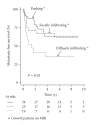Focus on the tumour periphery in MRI evaluation of soft tissue sarcoma: infiltrative growth signifies poor prognosis
- PMID: 17496992
- PMCID: PMC1779504
- DOI: 10.1155/SRCM/2006/21251
Focus on the tumour periphery in MRI evaluation of soft tissue sarcoma: infiltrative growth signifies poor prognosis
Abstract
Purpose. Infiltrative microscopical peripheral growth of soft tissue sarcomas (STS) has been shown to be of prognostic importance and preoperative risk stratification could individualize neoadjuvant treatment. Patients and methods. We assessed peripheral tumour growth pattern on preoperative MRI from 78 STS. The findings were correlated to histopathology and to outcome. Results. The MRI-based peripheral tumour growth pattern was classified as pushing in 34 tumours, focally infiltrative in 25, and diffusely infiltrative in 19. All tumours with diffuse infiltration on MRI also showed microscopical infiltration, whereas MRI failed to identify infiltration in two-thirds of the microscopically infiltrative tumours. Diffusely infiltrative growth on MRI gave a 2.5 times increased risk of metastases (P = .01) and a 3.7 times higher risk of local recurrence (P = .02). Discussion. Based on this observation we suggest that MRI evaluation of STS should focus on the peripheral tumour growth pattern since it adds prognostic information of value for decisions on neoadjuvant therapies.
Figures


Similar articles
-
Infiltrative tumor growth patterns on magnetic resonance imaging associated with systemic inflammation and oncological outcome in patients with high-grade soft-tissue sarcoma.PLoS One. 2017 Jul 20;12(7):e0181787. doi: 10.1371/journal.pone.0181787. eCollection 2017. PLoS One. 2017. PMID: 28727824 Free PMC article.
-
Preoperative Factors Associated with Infiltrative Histologic Growth Patterns in Extremity Soft Tissue Sarcoma.Sarcoma. 2017;2017:5419394. doi: 10.1155/2017/5419394. Epub 2017 Jul 20. Sarcoma. 2017. PMID: 28808411 Free PMC article.
-
MRI assessment of surrounding tissues in soft-tissue sarcoma during neoadjuvant chemotherapy can help predicting response and prognosis.Eur J Radiol. 2018 Dec;109:178-187. doi: 10.1016/j.ejrad.2018.11.004. Epub 2018 Nov 5. Eur J Radiol. 2018. PMID: 30527301
-
Lymphatic dissemination of bone and soft tissue sarcomas: a lymphographic investigation.Acta Radiol Suppl. 1976;349:1-84. Acta Radiol Suppl. 1976. PMID: 206099 Review.
-
The management of retroperitoneal soft tissue sarcoma: a single institution experience with a review of the literature.Eur J Surg Oncol. 2001 Aug;27(5):491-7. doi: 10.1053/ejso.2001.1146. Eur J Surg Oncol. 2001. PMID: 11504522 Review.
Cited by
-
The Impact of Edema on MRI Radiomics for the Prediction of Lung Metastasis in Soft Tissue Sarcoma.Diagnostics (Basel). 2023 Oct 5;13(19):3134. doi: 10.3390/diagnostics13193134. Diagnostics (Basel). 2023. PMID: 37835878 Free PMC article.
-
Soft-tissue sarcoma: modified grading method improves the accuracy of preoperative MRI in predicting patient outcomes.Eur Radiol. 2025 Aug;35(8):4571-4586. doi: 10.1007/s00330-025-11365-y. Epub 2025 Feb 6. Eur Radiol. 2025. PMID: 39915321
-
Infiltrative tumor growth patterns on magnetic resonance imaging associated with systemic inflammation and oncological outcome in patients with high-grade soft-tissue sarcoma.PLoS One. 2017 Jul 20;12(7):e0181787. doi: 10.1371/journal.pone.0181787. eCollection 2017. PLoS One. 2017. PMID: 28727824 Free PMC article.
-
Effect of Neoadjuvant Therapies on Soft Tissue Sarcomas with Tail-like Lesions: A Multicenter Retrospective Study.Cancers (Basel). 2021 Aug 2;13(15):3901. doi: 10.3390/cancers13153901. Cancers (Basel). 2021. PMID: 34359802 Free PMC article.
-
Preoperative Factors Associated with Infiltrative Histologic Growth Patterns in Extremity Soft Tissue Sarcoma.Sarcoma. 2017;2017:5419394. doi: 10.1155/2017/5419394. Epub 2017 Jul 20. Sarcoma. 2017. PMID: 28808411 Free PMC article.
References
-
- Cormier JN, Pollock RE. Soft tissue sarcomas. CA: A Cancer Journal for Clinicians. 2004;54(2):94–109. - PubMed
-
- Trovik CS, Bauer HC, Alvegard TA, et al. Surgical margins, local recurrence and metastasis in soft tissue sarcomas: 559 surgically-treated patients from the Scandinavian Sarcoma Group Register. European Journal of Cancer. 2000;36(6):710–716. - PubMed
-
- Gustafson P, Akerman M, Alvegard TA, et al. Prognostic information in soft tissue sarcoma using tumour size, vascular invasion and microscopic tumour necrosis-the SIN-system. European Journal of Cancer. 2003;39(11):1568–1576. - PubMed
-
- Wunder JS, Healey JH, Davis AM, Brennan MF. A comparison of staging systems for localized extremity soft tissue sarcoma. Cancer. 2000;88(12):2721–2730. - PubMed
-
- Varma DG. Imaging of soft-tissue sarcomas. Current Oncology Reports. 2000;2(6):487–490. - PubMed
LinkOut - more resources
Full Text Sources
Other Literature Sources

